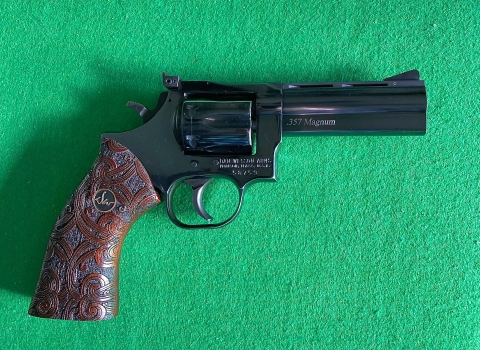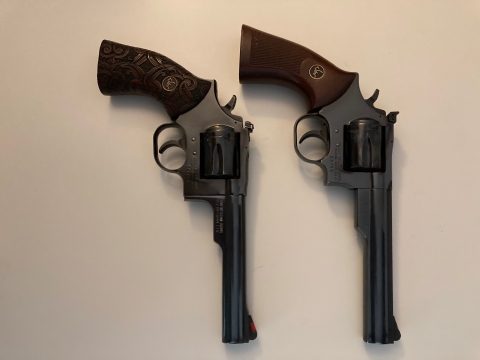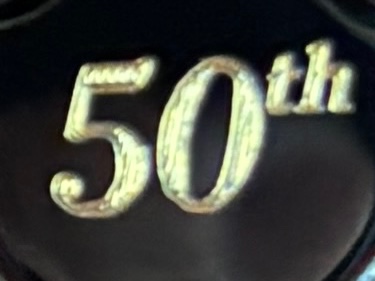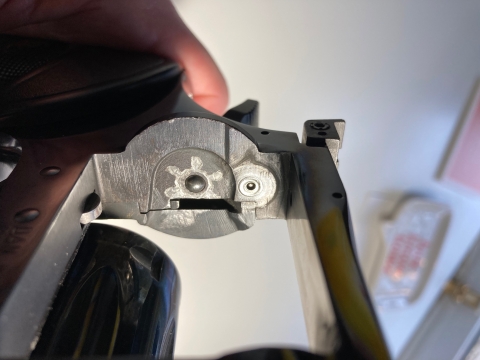October 17, 2017
 Offline
OfflineEndplay check: gage the barrel/cylinder gap with cylinder at rest, then push the cylinder rearward until it stops and gage the gap again. The difference between the two numbers is the amount of endplay present. It’s usually only a few thousandths. Colt says anything over 3 is out of spec; S&W allows a little more.
October 17, 2017
 Offline
OfflineThe newer (post 1977) DWs that have the improved crane take to shims just fine. The early ones with the removable cylinder gas ring can be problematic. I tried it on mine and the shim eventually moved enough to get caught up in the upper crane leg and bound up the cylinder. Perhaps a thicker shim would stay put better. I’ve used the shims in other revolvers and they work great!
October 17, 2017
 Offline
OfflinePerhaps not the place to post a DW photo, but since this is the gun that was the reason I started this topic over a year ago I thought I should post the final result of this journey. Cylinder/barrel gap - .004, endplay - not quite .002, headspace - .058 To celebrate having the revolver in top condition for the first time since I've owned it I decided to treat the old gal to some new shoes.


Dans Club
February 24, 2013
 Offline
OfflineOctober 17, 2017
 Offline
OfflineBeen doing some reading up on revolver frame “stretching”, and it seems to be a very rare occurrence. While this 15-2 has indeed been abused, and I’ve fired plenty of magnums in it before, I think it’s ok to run a few magnums occasionally especially since the endplay has now been reduced to a minimum. I’ll keep a close eye on any changes in barrel/cylinder gap after firing magnums, but they will be very few anyhow with the current price of ammo being what it is, and probably will be for the foreseeable future. 38 Special is my go-to now, and even they are getting hard to find at anywhere close to affordable.

Dans Club
February 24, 2013
 Offline
OfflineOctober 17, 2017
 Offline
Offline
 For the first time since my last post I was able to acquire enough .38 Special ammo to have a good session at the range; meaning the gun got a little hot, and I ran into a slight problem. [I’ve reposted the photo showing the extreme peening of the breech face for a visual reference (I hope I’m the owner of the only 15-2 that has been this badly abused).]Because of the peening, the headspace dimension is now variable since the ejector/ratchet no longer touches the breech when the gun is fired; the case head gets there first. As the gun heats up, the already meager headspace diminishes to the point that the case heads begin to drag on the breech as the cylinder turns; not enough to bind it up, but enough to put needless added stress on the action. The only cure was to set the cylinder a tad more forward so a bit more headspace could be maintained. The cylinder endplay is increased (when the gun is empty), but the actual endplay is acceptable when loaded and being fired because the case head is taking the place of the ejector/ratchet as the rearward stop. I may eventually run into ammo that has a rim too thick, and will bind, so I’m fortunate to have my 15-1 in “proper” working order that can handle any brand of ammo. So, the 15-1 has .060 headspace while the 15-2 has .057 The interesting part is the .003 feeler gauge that I can squeeze in there to check it is also the endplay dimension.
For the first time since my last post I was able to acquire enough .38 Special ammo to have a good session at the range; meaning the gun got a little hot, and I ran into a slight problem. [I’ve reposted the photo showing the extreme peening of the breech face for a visual reference (I hope I’m the owner of the only 15-2 that has been this badly abused).]Because of the peening, the headspace dimension is now variable since the ejector/ratchet no longer touches the breech when the gun is fired; the case head gets there first. As the gun heats up, the already meager headspace diminishes to the point that the case heads begin to drag on the breech as the cylinder turns; not enough to bind it up, but enough to put needless added stress on the action. The only cure was to set the cylinder a tad more forward so a bit more headspace could be maintained. The cylinder endplay is increased (when the gun is empty), but the actual endplay is acceptable when loaded and being fired because the case head is taking the place of the ejector/ratchet as the rearward stop. I may eventually run into ammo that has a rim too thick, and will bind, so I’m fortunate to have my 15-1 in “proper” working order that can handle any brand of ammo. So, the 15-1 has .060 headspace while the 15-2 has .057 The interesting part is the .003 feeler gauge that I can squeeze in there to check it is also the endplay dimension.
October 17, 2017
 Offline
OfflineWell, that didn’t take long. .38 Special ammo arrived yesterday, and the case head thickness is .057, so with a headspace of .057 these will surely drag a bit even before the gun heats up. I’ll have to run this batch through my 15-1. Don’t really want to open up the 15-2 any more since it’s rare to have case head thicknesses over .054 anyway, and the endplay is .003 as it is.
October 17, 2017
 Offline
OfflineSince there have been no responses, I’m guessing no one fully understands what I’m talking about here. Perhaps no one has ever had a 15-2 so badly abused? Most revolvers have the headspace/cylinder gap determined by the cylinder fit. Once the frame has become so deformed by excessive peening, the cylinder fit no longer determines end play/cylinder/barrel gap. Now it is the cartridge case head thickness that determines this critical dimension. So, if I have a batch of .38 Special ammo whose case rim thickness varies from .054 to .057, I’ll have a barrel/cylinder gap variance of .003, which means that I’m at the mercy of ammo manufacturing tolerances to keep my DW running smoothly. I don’t like this, but I’m stuck with it! Anyone else in this boat with me?
You may be one of those folks rowing solo across the ocean. I suspect most folks would have sold the gun and bought another by now. Or put it in a drawer. I have so many guns each one gets none or few rounds fired. Once I get my gun room built and get my stuff sorted out I plan on finding the guns I like the most and thinning the herd. Still, I don't think I will ever put enough rounds through a Dan to do that.
The Manurhin MR73 was developed because the Smith & Wessons the GIGN were using were wearing out /frame stretching after 30,000 rounds. That was one year of shooting. About what a serious IHMSA competitor would shoot. I think a Dan would last several times more than that. I have a lot of 15-2s and have never seen the rachet carve out the recoil shield like that.
October 17, 2017
 Offline
OfflineEverything I know about the DW 15-2 I learned the hard way by working on this revolver. It would be difficult to estimate the amount of time and money I have invested over the past 5 years, but the knowledge gained has been worth it. All of my .357 revolvers are close to 50 years old; this one just shows it a little more. In its present condition I’m sure it can still handle all the .38 Specials I can run through it in my lifetime, plus a few magnums along the way. It is now, and always has been a tack driver!
March 3, 2023
 Offline
OfflineHello everyone, new Owner of a Dan Wesson .44 Mag. I’ve been reading in this thread about end play and hammering of the recoil plate. I did some thinking on this. I’m no engineer but here is what I think. Let’s assume that a loaded cylinder weighs one pound, and the total end play is 0.010”, and the firing event is 1 millisecond long (as stated in other posts above) then the cylinder is traveling at a velocity of 0.83 ft/sec. when it stops against the recoil shield (0.010”/12” X .001sec) the one pound cylinder is 7000 grains in weight. Plugging these numbers in to my ballistics calculator gives me an impact force of 0.01 ft/lbs against the recoil shield. If my untrained assumptions are correct, then hammering due to end float has no effect on wear. It must all be due to the high chamber pressure pushing things apart.

 Register
Register Log In
Log In Home
Home







